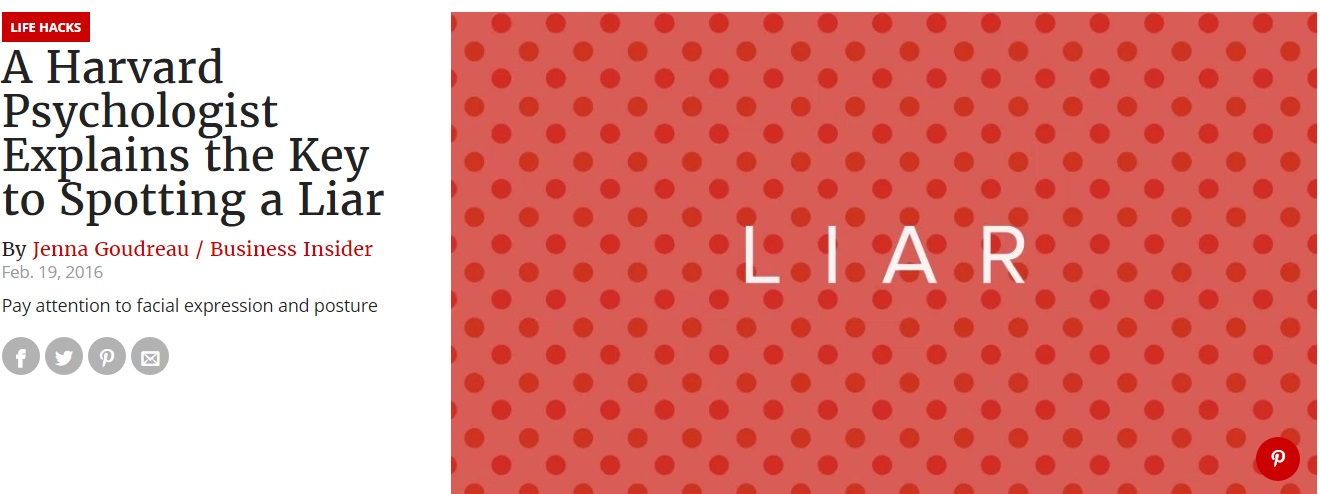
นักวิชาการ Harvard แนะนำการตรวจคำโกหก 10/10/2560
https://pantip.com/topic/36960346
A Harvard Psychologist Explains the Key to Spotting a Liar
By Jenna Goudreau / Business Insider
Feb. 19, 2016
Cr: Tawe Nop
อาจารย์สอนบริหารธุรกิจมหาวิทยาลัย Harvard ชื่อ Professor Amy Cuddy เขียนหนังสือ "Presence" ว่าด้วยการจับโกหกว่า การดูที่สายตาที่หลบหลีกอย่างเดียวไม่พอ ให้ดูพฤติกรรมภาพรวมว่ามีความขัดแย้งในช่องทางการสื่อสารต่างๆ เช่น สีหน้า ท่าทาง และการพูด รวมทั้งการกระทำต่างที่ขัดแย้งกับการพูด
ในสหรัฐฯ คุณสมบัติสำคัญเพื่อให้อาจารย์ผ่านการประเมินคือการเขียนหนังสือพิมพ์เผยแพร่ต่อสาธารณะสม่ำเสมอ มากกว่าผลงานทางวิชาการเหมือนบางประเทศที่อ่านกันไม่กี่คนแล้วไม่ยอมเผยแพร่
ผมเจอบ่อย อยากส่งให้นักศึกษา ป.เอกหลายๆหลักสูตรอ่านหรือให้อาจารย์ในหลักสูตรนำไปสอน ไปอ่านดูครับ
.. สรายุทธ จันทร์ 10/10/2560 21.31 น. กรุงเทพ
A Harvard Psychologist Explains the Key to Spotting a Liar
By Jenna Goudreau / Business Insider
Feb. 19, 2016
http://motto.time.com/4228269/key-spotting-a-liar-harvard/?xid=time_socialflow_facebook&utm_campaign=time&utm_source=facebook.com&utm_medium=social
Pay attention to facial expression and posture
You may think that fidgeting and not making eye contact are telltale signs that someone’s lying to you. But according to Harvard Business School professor Amy Cuddy, there is no one nonverbal cue that’s a dead giveaway.
In her new book “Presence,” the psychologist says that instead of looking for one big “reveal,” the best way to spot deception is to look for discrepancies across multiple channels of communication, including facial expressions, posture, and speech.
“Lying is hard work,” Cuddy says. “We’re telling one story while suppressing another, and if that’s not complicated enough, most of us are experiencing psychological guilt about doing this, which we’re also trying suppress. We just don’t have the brainpower to manage it all without letting something go — without ‘leaking.'”
The best way to catch these “leaks” is to look for differences between what people are saying and what they are doing, she says. Conflicting emotions, like a happy tone of voice paired with an agitated facial expression, can be particularly telling.
Unfortunately, people are generally pretty bad at spotting lies. They successfully identify lies only slightly better than someone simply guessing, Cuddy says. The problem is most of us focus too much on the content of what people are saying, and not enough on their actions and the alignment between the two.
She cites a study by Harvard psychologist Nancy Etcoff that found that people with a language-processing disorder were significantly better at spotting liars than those without the disorder, likely because they were not distracted by the words being said.
“When we’re consciously looking for signs of deception or truth, we pay too much attention to words and not enough to the nonverbal gestalt of what’s going on,” Cuddy says. “Truth reveals itself more clearly through actions than it does through our words.”



นักวิชาการ Harvard แนะนำการตรวจคำโกหก 10/10/2560 สรายุทธ กันหลง
นักวิชาการ Harvard แนะนำการตรวจคำโกหก 10/10/2560
https://pantip.com/topic/36960346
A Harvard Psychologist Explains the Key to Spotting a Liar
By Jenna Goudreau / Business Insider
Feb. 19, 2016
Cr: Tawe Nop
อาจารย์สอนบริหารธุรกิจมหาวิทยาลัย Harvard ชื่อ Professor Amy Cuddy เขียนหนังสือ "Presence" ว่าด้วยการจับโกหกว่า การดูที่สายตาที่หลบหลีกอย่างเดียวไม่พอ ให้ดูพฤติกรรมภาพรวมว่ามีความขัดแย้งในช่องทางการสื่อสารต่างๆ เช่น สีหน้า ท่าทาง และการพูด รวมทั้งการกระทำต่างที่ขัดแย้งกับการพูด
ในสหรัฐฯ คุณสมบัติสำคัญเพื่อให้อาจารย์ผ่านการประเมินคือการเขียนหนังสือพิมพ์เผยแพร่ต่อสาธารณะสม่ำเสมอ มากกว่าผลงานทางวิชาการเหมือนบางประเทศที่อ่านกันไม่กี่คนแล้วไม่ยอมเผยแพร่
ผมเจอบ่อย อยากส่งให้นักศึกษา ป.เอกหลายๆหลักสูตรอ่านหรือให้อาจารย์ในหลักสูตรนำไปสอน ไปอ่านดูครับ
.. สรายุทธ จันทร์ 10/10/2560 21.31 น. กรุงเทพ
A Harvard Psychologist Explains the Key to Spotting a Liar
By Jenna Goudreau / Business Insider
Feb. 19, 2016
http://motto.time.com/4228269/key-spotting-a-liar-harvard/?xid=time_socialflow_facebook&utm_campaign=time&utm_source=facebook.com&utm_medium=social
Pay attention to facial expression and posture
You may think that fidgeting and not making eye contact are telltale signs that someone’s lying to you. But according to Harvard Business School professor Amy Cuddy, there is no one nonverbal cue that’s a dead giveaway.
In her new book “Presence,” the psychologist says that instead of looking for one big “reveal,” the best way to spot deception is to look for discrepancies across multiple channels of communication, including facial expressions, posture, and speech.
“Lying is hard work,” Cuddy says. “We’re telling one story while suppressing another, and if that’s not complicated enough, most of us are experiencing psychological guilt about doing this, which we’re also trying suppress. We just don’t have the brainpower to manage it all without letting something go — without ‘leaking.'”
The best way to catch these “leaks” is to look for differences between what people are saying and what they are doing, she says. Conflicting emotions, like a happy tone of voice paired with an agitated facial expression, can be particularly telling.
Unfortunately, people are generally pretty bad at spotting lies. They successfully identify lies only slightly better than someone simply guessing, Cuddy says. The problem is most of us focus too much on the content of what people are saying, and not enough on their actions and the alignment between the two.
She cites a study by Harvard psychologist Nancy Etcoff that found that people with a language-processing disorder were significantly better at spotting liars than those without the disorder, likely because they were not distracted by the words being said.
“When we’re consciously looking for signs of deception or truth, we pay too much attention to words and not enough to the nonverbal gestalt of what’s going on,” Cuddy says. “Truth reveals itself more clearly through actions than it does through our words.”